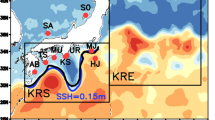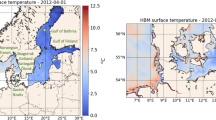Abstract
A data assimilation scheme used in the updated Ocean three-dimensional Variational Assimilation System (OVALS), OVALS2, is described. Based on a recursive filter (RF) to estimate the background error covariance (BEC) over a predetermined scale, this new analysis system can be implemented with anisotropic and isotropic BECs. Similarities and differences of these two BEC schemes are briefly discussed and their impacts on the model simulation are also investigated. An idealized experiment demonstrates the ability of the updated analysis system to construct different BECs. Furthermore, a set of three years experiments is implemented by assimilating expendable bathythermograph (XBT) and ARGO data into a Tropical Pacific circulation model. The TAO and WOA01 data are used to validate the assimilation results. The results show that the model simulations are substantially improved by OVALS2. The inter-comparison of isotropic and anisotropic BEC shows that the corresponding temperature and salinity produced by the anisotropic BEC are almost as good as those obtained by the isotropic one. Moreover, the result of anisotropic RF is slightly closer to WOA01 and TAO than that of isotropic RF in some special area (e.g. the cold tongue area in the Tropic Pacific).
Similar content being viewed by others
References
Barker D M, Huang W, Guo Y R, et al. 2004. A Three-Dimensional Variational Data Assimilation System for MM5: Implementation and Initial Results. Monthly Weather Review, 132: 897–913
Bertino L, Evensen G, Wackernagel H. 2002. Combining geostatistics and Kalman filtering for data assimilation in an estuarine system. Inverse Methods, 18: 1–23
Cohn S E, Da Silva A, Guo J, et al. 1998. Assesing the effects of data selection with the DAO physicalspace statistical analysis system. Monthly Weather Review, 126: 2913–2926
Courtier P E, Anderson W, Heckley J, et al. 1998. The ECMWF implementation of three dimensional variational assimilation (3D-Var), Part I: Formulation. The Quarterly Journal of the Royal Meteorological Society, 124: 1783–1808
Daley R. 1991. Atmospheric Data Assimilation. Cambridge University Press, 457
Derber J D, Rosati A. 1989. A global oceanic data assimilation system. Journal of Physical Oceanography, 19: 1333–1347
Dobricic S, Pinardi N. 2008. An oceanographic threedimensional variational data assimilation scheme. Ocean Modelling, 22: 89–105
Duchon C. 1979. Lanczos filtering in one and two dimensions. Journal of Applied Meteorology, 18, 1016–1022
Evensen G. 2003. The Ensemble Kalman Filter: theoretical formulation and practical implementation. Ocean Dynamics, 53: 343–367
Evensen G, van Leeuwen P J. 2000. An Ensemble Kalman Smoother for nonlinear dynamics. Monthly Weather Review, 128: 1852–1867
Evensen G. 2004. Sampling strategies and square root analysis schemes for the EnKF. Ocean Dynamics, 54: 539–560
Fujii Y. 2005. Preconditioned Optimizing Utility for Large-dimensional analyses (POpULar). Journal of Oceanography, 61: 167–181
Fujii Y, Kamachi M. 2003. A nonlinear preconditioned quasi-Newton method without inversion of a firstguess covariance matrix in variational analysis. Tellus, 55A: 450–454
Gao S, Wang F, Li M K, et al. 2008. Application of altimetry data assimilation on mesoscale eddies simulation. Science in China Series D: Earth Sciences, 51(1): 142–151
Gao J D, Xue M, Brewster K, et al. 2004. A Threedimensional Variational Data Analysis Method with Recursive Filter for Doppler Radars. Journal of Atmospheric and oceanic technology, 21: 457–469
Golub G H, Van Loan C F. 1996. Matrix computations. 3rd ed. Baltimore, USA: The Johns Hopkins University Press, 694
Gauthier P C, Cherette L, Fillion L, et al. 1998. Implementation of a 3D variational data assimilation system at the Canadian Meteorological Center. Part I: The global analysis. Atmosphere-Ocean, 37: 103–156
Haney R L. 1971. Surface thermal boundary conditions for ocean circulation model. Journal of Physical Oceanography, 1: 241–248
Huang X Y. 2000. Variational Analysis Using Spatial Filters. Monthly Weather Review, 128: 2588–2600
Hayden C M, Purser R J. 1995. Recursive Filter Objective Analysis of Meteorological Fields: Applications to NESDIS Operational Processing. Journal of Applied Meteorology, 34: 3–15
Heckley W A, Courtier P, Pailleux J, et al. 1992. The ECMWF variational analysis: general formulation and use of background information. In: ECMWF workshop proceedings. Variational assimilation with special emphasis on three-dimensional aspects. ECMWF, Reading, U.K., 49–94. Available from ECMWF, Shinfield Park, Reading, RG29AX, U. K.
Kaplan A, Kushnir Y, Cane M A. 2000. Reduced space optimal interpolation of historical marine sea level pressure: 1854–1992. Journal of Climate, 13: 2987–3002
Kuragano T, Kamachi M. 2000. Global statistical spacetime scales of oceanic variability estimated from the TOPEX/POSEIDON altimeter data. Journal of Geophysical Research, 105: 955–74
Lorenc A C. 1986. Analysis methods for numerical weather prediction. The Quarterly Journal of the Royal Meteorological Society, 112: 1177–1194
Lorenc A C. 1988. Optimal nonlinear objective analysis. The Quarterly Journal of the Royal Meteorological Society, 114: 205–240
Lorenc A C, Ballard R S, Ingleby N B, et al. 2000. The Met. Office global three-dimensional variational data assimilation scheme. The Quarterly Journal of the Royal Meteorological Society, 126: 2991–3012
Liu Y, Zhu J, She J, et al. 2009. Assimilating temperature and salinity profile observations using an anisotropic recursive filter in a coastal ocean model. Ocean Modelling, 30: 75–87
Liu H, Xue M. 2006. Retrieval of moisture from slantpath water vapor observations of a hypothetical GPS network using a three-dimensional variational scheme with anisotropic background error. Monthly Weather Review, 134: 933–949
Liu Y, Yan C X. 2010. Application of recursive filter to a three dimensional variational ocean data assimilation system. Advance of Atmospheric Sciences, 27(2): 293–302
Maes C, Behringer D, Reynolds R W, et al. 2000. Retrospective analysis of the salinity variability in the western Tropical Pacific Ocean using an indirect minimization approach, Journal of Atmospheric and oceanic technology, 17: 512–524
Pham D T. 2001. Stochastic methods for sequential data assimilation in strongly nonlinear systems. Monthly Weather Review, 129: 1194–1207
Oke P R, Sakov P, Corney Stuart P. 2007. Impacts of localisation in the EnKF and EnOI: experiments with a small model. Ocean Dynamics, 57: 32–45
Parrish D F, Derber J C. 1992. The National Meteorological Center’s spectral statistical-interpolation analysis system. Monthly Weather Review, 120: 1747–1763
Purser R J, Wu W S, Parrish D F, et al. 2003a. Numerical aspects of the application of recursive filters to variational statistical analysis. Part I: Spatially homogeneous and isotropic Gaussian covariances. Monthly Weather Review, 131: 1524–1535
Purser R J, Wu W S, Parrish D F. 2003b. Numerical aspects of the application of recursive filters to variational statistical analysis. Part II: Spatially inhomogeneous and anisotropic general covariances. Monthly Weather Review, 131: 1536–1548
Riishøjgaard L P. 1998. A direct way of specifying flowdependent background error correlations for meteorological analysis systems. TellusA, 50: 42–57
Wang X D, Xu D F, Xu X H. 2008. Incremental 4D-VAR assimilation scheme based on Lorenz model. Acta Oceanologica Sinica, 27: 93–100
Wu W S, Purser R J, Parrish D F. 2002. Three dimensional variational analysis with spatially inhomogeneous covariances.. Monthly Weather Review, 130: 2905–2916
Xiao X J, Wang D X, Yan C X, et al. 2008. Evaluation of a 3dVAR system for the South China Sea. Progress in Nature sciences, 18: 547–554
Yan C X, Zhu J, Zhou G Q. 2007. Impacts of XBT, TAO, Altimetry and ARGO Observations on the Tropical Pacific Ocean Data Assimilation. Advances in Atmospheric Sciences, 24(3): 383–398
Zhang R H, Endoh M. 1992. A free surface general circulation model for the tropical Pacific Ocean. Journal of Geophysical Research, 97(C7): 11237–11255
Zheng F, Zhu J. 2008. Balanced multivariate model errors of an intermediate coupled model for ensemble Kalman filter data assimilation. Journal of Geophysical Research, 113, C07002, doi:10.1029/2007JC004621
Zheng F, Zhu J, Zhang R H. 2006. Improved ENSO forecasts by assimilating sea surface temperature observations into an intermediate coupled model. Advances in Atmospheric Sciences, 23(4): 615–624
Zhu J, Zhou G Q, Yan C X, et al. 2006. A threedimensional variational ocean data assimilation system: Scheme and preliminary results. Science in China Series D: Earth Sciences, 49(11): 1212–1222
Author information
Authors and Affiliations
Corresponding author
Additional information
Foundation item: Major National Scientific Research Project on Global Change under contract No. 2010CB951901; the National Science Foundation of China under contract No. 40821092; Special Fund for Public Welfare Industry (Meteorology) under contract No.GYHY200906018.
Rights and permissions
About this article
Cite this article
Liu, Y., Zhao, Y. Assimilation of temperature and salinity using isotropic and anisotropic recursive filters in Tropic Pacific. Acta Oceanol. Sin. 30, 15–23 (2011). https://doi.org/10.1007/s13131-011-0086-7
Received:
Accepted:
Published:
Issue Date:
DOI: https://doi.org/10.1007/s13131-011-0086-7




